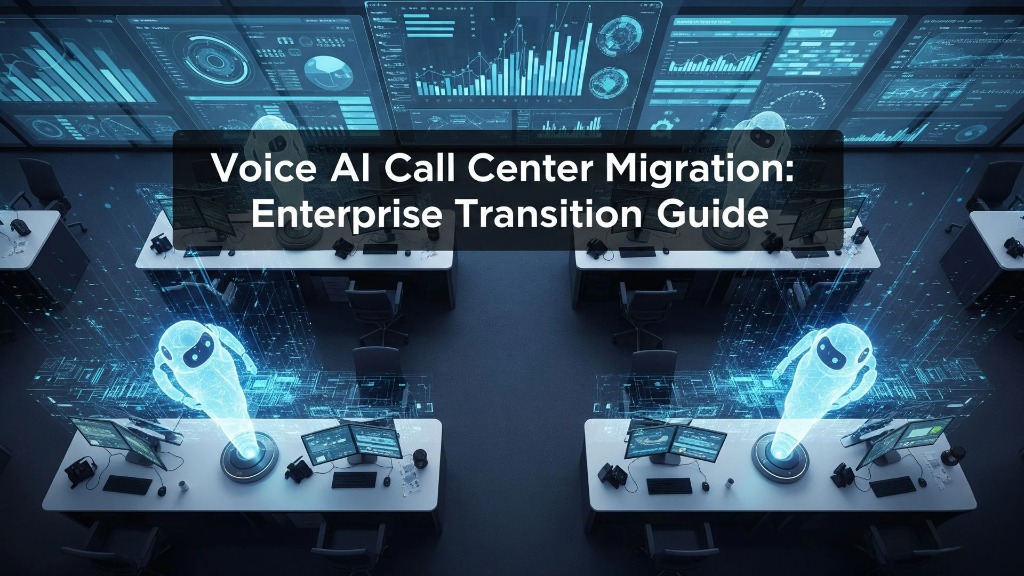Voice AI call center technology transforms customer service operations completely. Traditional call centers face increasing pressure to modernize systems. Call center migration to AI-powered solutions reduces costs while improving service quality. Enterprise organizations must plan transitions carefully for maximum success.
Table of Contents
Understanding Voice AI Call Center Technology
Modern customer service requires intelligent automation solutions. Voice AI handles routine inquiries without human intervention. The technology processes natural language conversations effectively. Customer satisfaction improves through faster response times.
Voice AI systems learn from every customer interaction. They understand context and intent accurately. Complex queries get routed to human agents automatically. Simple requests receive immediate AI-powered responses.
Benefits of Call Center Migration to Voice AI
Cost Reduction
Voice AI call center solutions significantly reduce operational expenses. Companies eliminate the need for large agent teams. Automation handles high-volume routine calls efficiently. Labor costs decrease by 40-60% after migration.
Improved Customer Experience
Customers receive instant responses to common questions. Wait times disappear for basic inquiries. Voice AI provides consistent service quality. Customer satisfaction scores increase after implementation.
Enhanced Scalability
Voice AI systems handle unlimited concurrent calls. Peak traffic periods no longer overwhelm operations. Seasonal fluctuations become manageable. Business growth doesn’t require proportional staffing increases.
Pre-Migration Assessment
Current System Analysis
Evaluate existing call center infrastructure thoroughly. Document current call volumes and types. Identify frequently asked questions and common issues. Assess agent performance metrics across different categories.
Technology Readiness
Review current telephony systems compatibility. Check internet bandwidth requirements. Evaluate existing CRM integration capabilities. Ensure security protocols meet industry standards.
Call center migration requires careful technical planning. Voice AI systems need robust internet connectivity. Legacy phone systems may require upgrades. Data security becomes paramount during transitions.
Staff Impact Assessment
Analyze current staffing levels and roles. Identify agents suitable for retraining opportunities. Plan for workforce transition timelines. Consider employee retention strategies during changes.
Planning Your Voice AI Call Center Migration
Phase 1: Infrastructure Preparation
Upgrade network infrastructure to support voice AI. Install necessary hardware and software components. Configure integration points with existing systems. Test connectivity and performance thoroughly.
Phase 2: Data Migration
Transfer customer data to new voice AI platforms. Import historical call records and interactions. Configure customer profiles and preferences. Ensure data integrity throughout the process.
Phase 3: AI Training
Voice AI call center systems require extensive training data. Upload call recordings and transcripts. Configure intent recognition and response patterns. Test accuracy rates with sample interactions.
Implementation Strategies
Pilot Program Approach
Start with a small subset of call types. Test voice AI performance with limited customer groups. Monitor quality metrics during initial deployment. Refine systems based on real-world feedback.
Gradual Rollout
Expand voice AI coverage incrementally. Add new call types and customer segments progressively. Train staff on updated processes regularly. Maintain quality standards throughout expansion.
Parallel Operation
Run voice AI alongside existing systems temporarily. Compare performance metrics between approaches. Identify optimization opportunities early. Ensure seamless transition for customers.
Training and Change Management
Agent Retraining
Existing agents need new skills for voice AI environments. Train staff on escalation procedures and protocols. Develop expertise in handling complex customer issues. Focus on value-added services and relationship building.
Management Training
Supervisors require training on voice AI management tools. Teach performance monitoring and quality assurance methods. Develop skills in AI system optimization. Focus on strategic oversight rather than tactical management.
Call center migration impacts entire organizational structures. Management roles evolve from direct supervision to strategic planning. Voice AI systems provide detailed analytics and insights. Decision-making becomes more data-driven and efficient.
Customer Communication
Inform customers about voice AI implementation plans. Explain benefits and improved service capabilities. Provide options for human agent interactions. Maintain transparency throughout the transition process.
Quality Assurance and Monitoring
Performance Metrics
Monitor first-call resolution rates continuously. Track customer satisfaction scores closely. Measure response times and accuracy rates. Compare metrics against pre-migration baselines.
Continuous Improvement
Voice AI systems improve through ongoing optimization. Regular updates enhance recognition accuracy. Customer feedback guides system refinements. Performance analytics identify improvement opportunities.
Compliance Management
Ensure voice AI systems meet regulatory requirements. Maintain call recording and documentation standards. Implement proper data protection measures. Regular audits verify compliance adherence.
Common Migration Challenges
Technical Integration Issues
Legacy systems may require significant modifications. Data format compatibility can present obstacles. Network performance impacts voice AI effectiveness. Work with experienced integration partners.
Staff Resistance
Employees may fear job displacement initially. Communicate career development opportunities clearly. Provide comprehensive training and support. Emphasize human-AI collaboration benefits.
Customer Adaptation
Some customers prefer human interaction exclusively. Voice AI should recognize these preferences quickly. Provide easy escalation paths to human agents. Maintain customer choice and flexibility.
ROI and Success Metrics
Cost Savings Calculation
Calculate reduced labor costs accurately. Include infrastructure savings and efficiency gains. Account for training and implementation expenses. Most organizations see positive ROI within 12-18 months.
Quality Improvements
Measure customer satisfaction improvements quantitatively. Track first-call resolution rate increases. Monitor complaint reduction percentages. Document service quality enhancements.
Operational Efficiency
Voice AI call center operations handle more calls efficiently. Average handle time decreases for routine inquiries. Agent productivity increases on complex issues. Overall operational capacity expands significantly.
Future-Proofing Your Migration
Scalability Planning
Design voice AI systems for future growth. Plan for increased call volumes and complexity. Consider multi-channel integration capabilities. Prepare for evolving customer expectations.
Technology Evolution
Voice AI technology advances rapidly. Plan for regular system updates and improvements. Maintain compatibility with emerging standards. Invest in flexible and adaptable platforms.
Competitive Advantage
Early voice AI adoption provides market advantages. Customer service quality becomes a differentiator. Operational efficiency reduces costs permanently. Innovation leadership attracts better talent.
Best Practices for Success
Start Small
Begin with simple use cases and call types. Prove value before expanding scope significantly. Learn from initial experiences systematically. Build confidence through early wins.
Focus on Customer Experience
Prioritize customer satisfaction throughout migration. Maintain service quality during transitions. Gather feedback continuously and respond quickly. Customer experience drives long-term success.
Read More: AI Calling Audit Trails: Record-Keeping For Legal Protection
Invest in Training
Comprehensive training ensures successful adoption. Both technical and soft skills need development. Ongoing education maintains competency levels. Well-trained teams deliver better results.
Voice AI call center migration represents a significant business transformation. Companies that plan carefully achieve better outcomes. The technology continues evolving and improving rapidly. Organizations must embrace change to remain competitive in modern markets.





